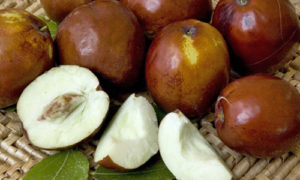 The jujube, sometimes called Chinese date, is an unusual tree that isn’t picky where you plant it, as it will grow most anywhere. Hot and sunny is the preferred environment for good crops. And the fruits are delicious, fresh from the tree as they begin to turn color, fully colored, or dried like a prune or raisin. These small to medium sized trees have lovely shiny green leaves, which turn a pretty yellow in fall. About the only negative I can think of is there are a few thorns on most young shoots. Actually, deer like them, much as they do apple trees, so that could be a drawback in more rural settings.
The jujube, sometimes called Chinese date, is an unusual tree that isn’t picky where you plant it, as it will grow most anywhere. Hot and sunny is the preferred environment for good crops. And the fruits are delicious, fresh from the tree as they begin to turn color, fully colored, or dried like a prune or raisin. These small to medium sized trees have lovely shiny green leaves, which turn a pretty yellow in fall. About the only negative I can think of is there are a few thorns on most young shoots. Actually, deer like them, much as they do apple trees, so that could be a drawback in more rural settings.
The jujube tree is about as good as they come if you want to grow a nice homegrown fruit organically, and even if you don’t have a “green thumb” you will probably succeed with this tree. Drought isn’t a problem after the first year or two. Salt from city streets or the seashore; not a problem. And it looks as good as a redbud or a katusra tree with the added benefit of wonderful fruit.
Jujube fruits are roughly size of a cherry to size of a large plum, depending on the variety. One seed also like the plum or cherry. They are edible but bland when they are green. As they ripen, they get sweeter. And, dehydrated, they are like dates or raisins or dried figs in sweetness. If you live in a drier climate with little late season rainfall, they will dry right up on the tree, and can be picked and stored as you might store raisins.
From Houston, Texas to Cincinnati or Washington, DC you can successfully grow this tree. In USDA zone 5 it may damage in winter but still live and regrow. Someone has said “No other tree gives me so much pleasure for so little effort.”
Most jujube trees are at least partly self fruitful, but having two or more varieties will insure good pollination.
These cultivars are self fertile: Li, Coco, and Shanx.Li. Most are somewhat self fertile, at least one exception is Lang.
The Li variety is easy to find, bears early in the season, and is self fruitful. Some of the sweetest are Honey Jar,, Sugar Cane and GA 866. With names like honey and sugar, they must be sweet!
Sugar Cane would make a good hedge, as it has the most thorns. The variety called “So” is contorted and most unusual. Sherwood makes a more tall and narrow tree, and they all appear to “weep” especially when loaded with fruits.
Other named varieties include these: Chico, SiHong, Black Sea, and Massandra. Ta-Jan might be your preference if a bit of acidity sounds good mixed with the sweetness.
Jujube fruit has 20 times the vitamin C of citrus. One sweet little jujube or one big sour grapefruit….your choice! The trees bud and leaf late, and bloom early summer. This makes them pretty much immune to frost.
The wood is durable, valuable, very useful. From wooden implement handles, furniture, gun stocks to a firewood that burns hot like hickory, the beautiful red wood would be treasured by a woodworker.
Always game to try new and unusual plants and fuits, I don’t know why it took me until the last couple years to taste this fruit, and to obtain a tree. Because I think every yard should have one, and every orchard should have several. (You’ll have trouble finding these trees, but an internet search or your favorite mailorder nursery catalog may be able to supply some.) I recommend the tree for landscaping purposes, as well as for it’s fruits.